- Details
-
Created: Thursday, 02 March 2006 07:06
We hadn’t planned to go to France at all, but when the opportunity arrived, it seemed foolish not to take advantage of it, and how glad I am that we did. Wade and Tonie Marlow, owners of the Blue Horse gallery in Bellingham, lead artists’ tours to many European places. When we met in September ‘04, they were setting up a trip to Paris and the Loire Valley, and by a fortuitous turn of events, Maralyne and I were ready for an adventure just then. We signed up right away. May of 2005 was magical.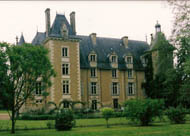
Twenty of us went, flying from Sea Tac Airport to London, and then on to Paris. Wade has a great system. He arranges all the travel and lodging, he showed us how to buy cheap museum passes and to use the Metro, and did a few brief museum introductions, then turned us loose to either go our own ways or continue to tour the city with him. And while it is true that you can’t possibly see everything you want to, this method allowed us to get a quick overview, and then concentrate on getting to know a choice few aspects of this fantastic place.
We stayed in a small hotel on the Boulevard Haussmann, just a few blocks north of the Place de Concord. The first night in town, Wade suggested we walk around a while to get our body clocks reset, before turning in, and so we just scattered.
None of us had been in France before, and not knowing where to go, my first impulse was to go see the Seine River, so Maralyne and I just started zigzagging southward, until we came upon the Alexander III Bridge. What a stunning sight! Huge limestone columns with both relief and full figure carvings on them, topped by gilded bronze equestrian statues 40 feet in the air. I was awestruck. I started fondling the sculptures, and I didn’t stop for a whole week, even after being chastised in three museums.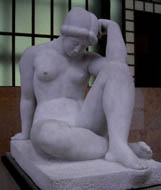
I don’t know who most of the carvers were, and it was clear that Rodin didn’t invent these beautiful forms: he grew up with them everywhere. All over Paris we saw marble and limestone and bronze and aluminum marvels. In the Louvre, the d’Orsay, and all the museums we visited, old statues, new statues, every size and subject. The best for me were the hundreds of figures in the Tuileries, the great park outside the Louvre, where kids climbed on luscious Maillol bronzes, and pigeons swooped down from stained marble representations of Greek myths. They were all just as alive as the chestnut trees and lazy lovers lounging everywhere.
And the churches! Fantastic! Notre Dame certainly, and St. Chapelle, and dozens more, all swarming with gargoyles outside and saints and martyrs inside. I wish I could describe these wonders, but it was so overwhelming to somebody who has grown up in this juvenile country, to confront mature cultural expressions, on every corner, in every shop, every street, every park. I couldn’t take it all in. It was too wonderful. But here are a couple sights that really knocked me flat.
One is the gorgeous statue of St Mary Magdalene in the Madeleine Church. Carved by Carlo Marochetti from one block of white marble, about 1840. It is romantic, sentimental, and glowing with magic.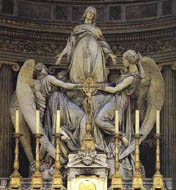
Another is the Winged Victory of Samothrace, in the Louvre. This is one of those Classical Greek moments of glory, so battered and broken, but so full of power still that it completely fills and dominates the generous atrium it occupies. This one made me cry like a baby, and I couldn’t keep my hands off the broken spot where her feet used to be (that’s all I could reach).
Then there is Maillol’s Mediterranean in Musee d’Orsay, a warm and tender limestone lady. Also irresistible, and a cause for one of my most vehement scoldings by museum guards. The other came at the Rodin Museum, but I honestly couldn’t help myself.
Obviously, Paris is too grand and wonderful to describe, so all I can say is you gotta go there yourself!
The second week in France we spent at the groovy Chateau St. Julien l’Ars, just outside of Chauvigny. This was a whole different France, about three hours south by car, near the old capitol Poitiers. Here we shared a restored castle which had been built during the 13th, 15th, and 17th centuries, now owned by a couple from Seattle, who rent it out for parties, weddings, and tour group vacations. It sleeps 50, with a huge dining hall, a medieval bell tower, and beautifully landscaped grounds. We shared the shopping, cooking and dishwashing duties, and lived it up for about one third what we had paid for meals in Paris.
Most of the folks in our group painted, drew, and took photographs in and around the chateau, and in several towns nearby. I had other ideas. For three delightful days, I carved, using a hundred pound limestone block that had come out of one of the old garden walls, with tools I found at the local flea market and hardware store. I shared the warm soft sunlight with doves and crows and lazy cats. A little mermaid with my initials on it now sits by a pond in the back yard there. And a little piece of my heart. I am going back for more.
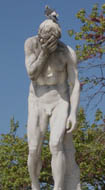
If any of you brothers and sisters want to have a similar dream vacation, Wade and I are setting up a combination trip, half painters, half carvers, tentatively set for September 9-24, 2007. We’ll have four days in Paris, guided or not at your convenience. Then 10 days in St Julien, carving delicious Chauvigny limestone, and savoring the local bread, food, and wine. While at the Chateau we will have a fleet of rental cars, and you can spend the whole time day tripping if you like. I hope to have a brochure ready by April, and am happy to talk more about it to anybody who is curious.
Wade Marlow is at Blue Horse Gallery, 301 W Holly, M-1, Bellingham, WA 98225, phone 360-671-3426. His email address is This email address is being protected from spambots. You need JavaScript enabled to view it.. I am in Anacortes, and you can email me at This email address is being protected from spambots. You need JavaScript enabled to view it., or call me at 360-293-3237. If you want to see the chateau online, go to www.chateaustjulien.com.
If you want to learn more about France and its sculptors, you should probably ask Irene Hewins, a French sculptor and long-term NWSSA member. Irene is one of the veterans of symposia past, who carves gorgeous abstracted figures in marble, limestone, and alabaster. She is also a lovely lady to whom I will say, “You were right Baby, I should have gone there a long time ago! C’est magnifique!”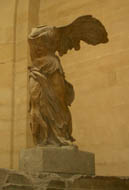
- Details
-
Created: Thursday, 02 March 2006 06:59
Leon White remembers washing his sculpture of colorful steel flowers in the Issaquah Highlands last summer, when some joggers and cyclists stopped to thank him for brightening up their mornings with the piece.
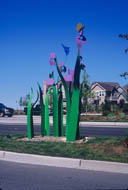
“It was nice to have people actually notice it,” he said.
Residents’ positive reaction to the installation - called “Miracle Grow” - prompted the City Council this week to buy it for $18,000.
White’s work was part of Issaquah’s three-year-old Loaned Art Program, which borrows public art from local and regional artists and displays the pieces in various locations for one year. Artists receive $500 for transportation and installation costs. Six loaned pieces reside in Issaquah now.
The concept has gained in popularity over the years, with cities from Puyallup to Bellevue to Wenatchee creating their own programs. The mutually beneficial exchange gives cities a steady rotation of artwork for a minimal cost, while artists get exposure.
“Art adds talking points in a city,” said Susan Coombes, Issaquah arts commissioner. “It contributes greatly to the character of a city and increases community
pride.” It also draws tourists. And with tourists come dollars.
“It’s all about attracting people to your community,” said Kris Bassett, Wenatchee Arts Commission staffer. “Maybe they say, ‘Let’s go see the art in Wenatchee.’ Well, they have to eat. Then they might shop. So I see it as a whole big picture.”
The city of Bellevue has been exhibiting sculptures at its Downtown Park since 1992. The display of borrowed art runs from mid-June through October. Redmond relies on loaned art for its outdoor sculpture garden at Redmond Town Center, as does part of Puyallup’s Outdoor Gallery collection
In deciding which pieces make the cut, arts commis-sioners generally look for work that is durable and aesthe-tically exciting, staying away from religious or obscenity-laced themes. The importance of sturdiness in the artwork cannot be emphasized enough, said Mary Pat Byrne, arts specialist for Bellevue.
“People love to get their arms around the art,” she said. “If it’s at all climbable, we want to make sure that it’s strong enough to stand up to this tough love.”
Lending also provides a chance for artists to sell their work either to cities or individuals - although there are no guarantees. “We don’t ever promise the artist that we’ll buy,” said Byrne.
Sometimes a piece will be so powerful that people will stop, stare or even tear up, she said. She remembered one from 2002, called the “Wall of Masks,” that elicited such emotion. The work was done by Bellevue teenagers who created self-portraits in the form of masks. One was of a weeping angel’s head and wings; another was made of barbed wire.
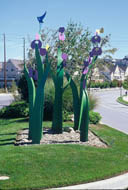
Of course, not all artwork invokes awe. Some can be remembered just as vividly for drawing jeers.
Probably the most infamous loaned art in Issaquah was a 5-foot, 10-inch blue steel circle with three holes in it that used to sit across from the Village Theatre. Named “What Icarus Saw,” it soon earned the moniker “The Blue Blob.”
People “don’t always like every piece that we put out, but at least it gets them talking about art,” Coombes said.
White, 52, said he likes to throw in a bit of humor, hence the pun in the title of his “Miracle Grow” piece.
“It’s kind of like, hey, someone threw some Miracle-Gro on this and look what happened,” he said.
It’s not imperative all art carry some kind of a deeper meaning, said Coombes. The “Miracle Grow” piece, she said, is one such example.
“It offered such a welcoming sight and it makes you smile when you drive by it,” she said.
Copyright © 2006 The Seattle Times.
Used with permission
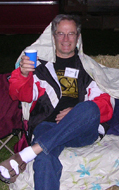 Cans of compressed air, like for computer dusting, are a good solution for cleaning surfaces prior to waxing or gluing, or cleaning out holes. Keep your powered sander or polisher moving: overheating the stone can cause an aggravating milky effect in it. The sandblasting class last year at Silver Falls by Lisa Ponder came in handy. A light treatment produced a nice satin finish on a piece of slate. It also cleaned up the natural surface I wanted to preserve of a piece of soapstone. Make sure your base is ready when the last polishing is complete on the sculpture. Last minute modifications to the assembly can be avoided if the “final image” has been scoped out. It can also allow the finished piece to be moved to a safe haven, rather than kicking around the studio awaiting a base.
Cans of compressed air, like for computer dusting, are a good solution for cleaning surfaces prior to waxing or gluing, or cleaning out holes. Keep your powered sander or polisher moving: overheating the stone can cause an aggravating milky effect in it. The sandblasting class last year at Silver Falls by Lisa Ponder came in handy. A light treatment produced a nice satin finish on a piece of slate. It also cleaned up the natural surface I wanted to preserve of a piece of soapstone. Make sure your base is ready when the last polishing is complete on the sculpture. Last minute modifications to the assembly can be avoided if the “final image” has been scoped out. It can also allow the finished piece to be moved to a safe haven, rather than kicking around the studio awaiting a base.







